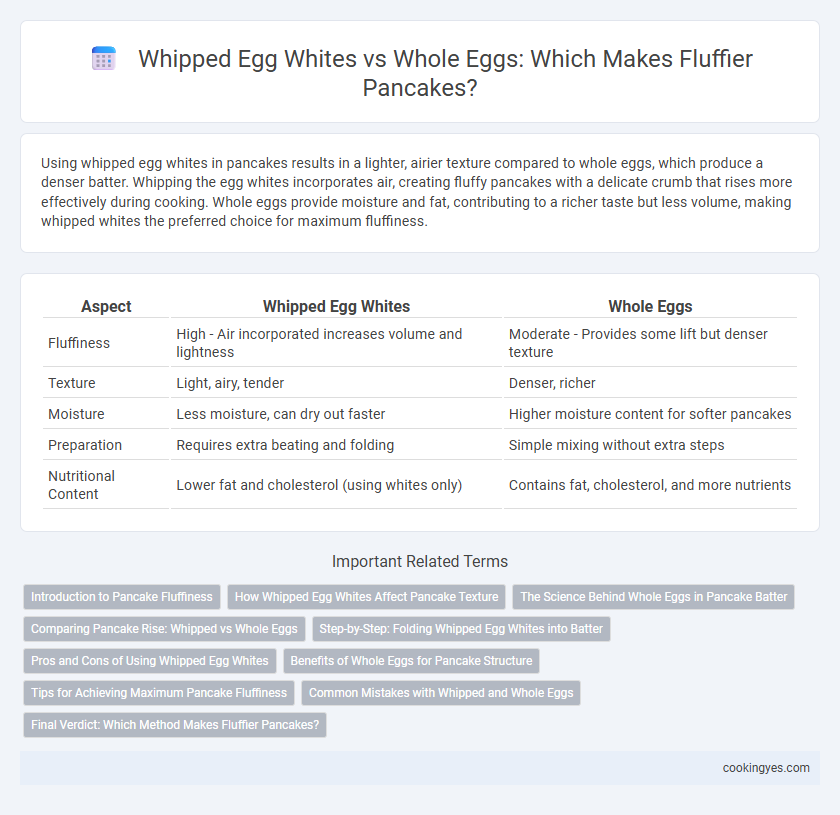Using whipped egg whites in pancakes results in a lighter, airier texture compared to whole eggs, which produce a denser batter. Whipping the egg whites incorporates air, creating fluffy pancakes with a delicate crumb that rises more effectively during cooking. Whole eggs provide moisture and fat, contributing to a richer taste but less volume, making whipped whites the preferred choice for maximum fluffiness.
Table of Comparison
| Aspect | Whipped Egg Whites | Whole Eggs |
|---|---|---|
| Fluffiness | High - Air incorporated increases volume and lightness | Moderate - Provides some lift but denser texture |
| Texture | Light, airy, tender | Denser, richer |
| Moisture | Less moisture, can dry out faster | Higher moisture content for softer pancakes |
| Preparation | Requires extra beating and folding | Simple mixing without extra steps |
| Nutritional Content | Lower fat and cholesterol (using whites only) | Contains fat, cholesterol, and more nutrients |
Introduction to Pancake Fluffiness
Whipped egg whites create tiny air bubbles that trap heat during cooking, resulting in lighter and fluffier pancakes compared to using whole eggs. Whole eggs provide richness and moisture but produce denser pancakes due to the lack of incorporated air. Understanding the role of egg whites in aeration is essential for achieving the ideal pancake texture.
How Whipped Egg Whites Affect Pancake Texture
Whipped egg whites create air bubbles that expand during cooking, resulting in lighter, fluffier pancakes with a tender crumb. This aeration technique enhances the pancake's volume and gives a delicate, airy texture compared to using whole eggs. The protein structure in whipped whites stabilizes this air, improving overall pancake rise and softness.
The Science Behind Whole Eggs in Pancake Batter
Whole eggs in pancake batter provide essential proteins and fats that contribute to a tender crumb and balanced texture by unfolding and coagulating during cooking to create structure. The yolk's emulsifying properties aid in fat distribution, resulting in a moist and rich pancake. Unlike whipped egg whites, whole eggs produce consistent fluffiness through chemical reactions that trap steam and support rise without over aerating the batter.
Comparing Pancake Rise: Whipped vs Whole Eggs
Whipped egg whites create more air bubbles in pancake batter, resulting in a significantly higher rise and lighter texture compared to whole eggs. Pancakes made with whipped egg whites have increased volume and a fluffier crumb, while whole eggs contribute to moisture and richness but yield a denser pancake. This difference is due to the protein structure in egg whites trapping air during whipping, enhancing the batter's aeration and rise.
Step-by-Step: Folding Whipped Egg Whites into Batter
Folding whipped egg whites into pancake batter involves gently incorporating the air-filled whites to maximize fluffiness without deflating them. Start by beating egg whites until stiff peaks form, then carefully fold a small portion into the batter to lighten it before folding in the rest with slow, sweeping motions using a spatula. This technique preserves the trapped air, resulting in pancakes with a light, airy texture compared to using whole eggs alone.
Pros and Cons of Using Whipped Egg Whites
Whipped egg whites create a lighter, airier pancake texture by incorporating more air into the batter, resulting in enhanced fluffiness compared to whole eggs. This method allows better control over the pancake's volume and reduces density but requires extra preparation time and delicate folding to avoid deflating the mixture. Using whipped egg whites can improve fluffiness, yet whole eggs contribute more moisture and flavor, making the choice dependent on preferred texture and taste balance.
Benefits of Whole Eggs for Pancake Structure
Whole eggs contribute to pancake structure by providing proteins that coagulate during cooking, creating a stable network that supports the batter's rise and maintains fluffiness. The fat in egg yolks adds moisture and tenderness, enhancing the overall texture without compromising density. Using whole eggs balances lift and structure, resulting in pancakes that are both fluffy and resilient.
Tips for Achieving Maximum Pancake Fluffiness
Whipped egg whites create air pockets that significantly increase pancake fluffiness by incorporating more volume than whole eggs. For maximum fluffiness, beat egg whites until stiff peaks form and gently fold them into the batter to maintain the aeration. Using fresh eggs and avoiding overmixing the batter further enhances the light, airy texture essential for perfect pancakes.
Common Mistakes with Whipped and Whole Eggs
Using whipped egg whites instead of whole eggs can increase pancake fluffiness, but overbeating the whites often causes them to collapse, resulting in dense pancakes. Incorporating whole eggs incorrectly by mixing too vigorously may deflate the batter, reducing air retention and puffiness. Ensuring gentle folding of whipped egg whites and proper mixing techniques with whole eggs is essential to avoid common texture mistakes in fluffy pancakes.
Final Verdict: Which Method Makes Fluffier Pancakes?
Whipped egg whites create air pockets that significantly increase pancake volume and lightness, resulting in a noticeably fluffier texture compared to whole eggs. Incorporating separated and beaten egg whites into pancake batter enhances lift without compromising moisture or flavor. For maximum fluffiness, using whipped egg whites is the preferred technique over whole eggs.
Whipped Egg Whites vs Whole Eggs for Pancake Fluffiness Infographic

 cookingyes.com
cookingyes.com